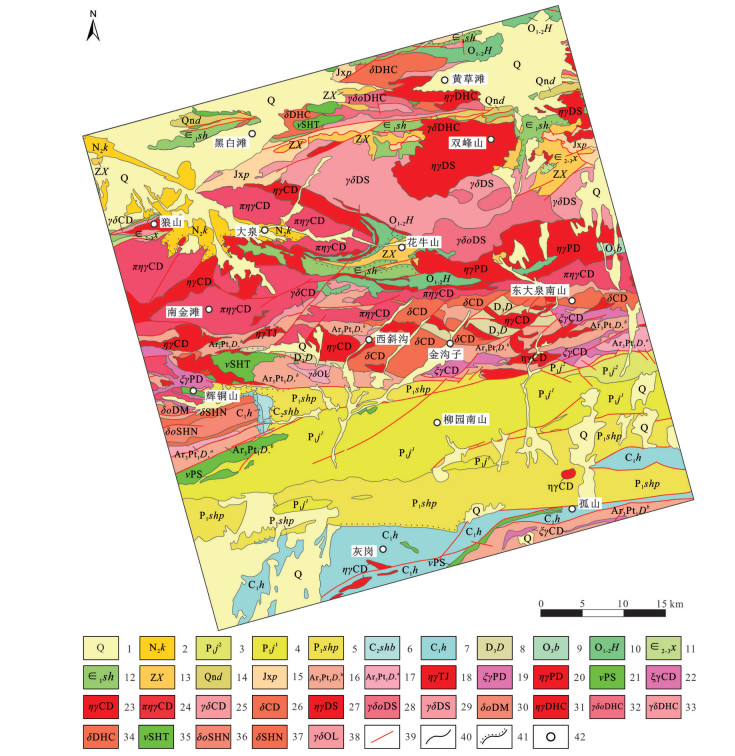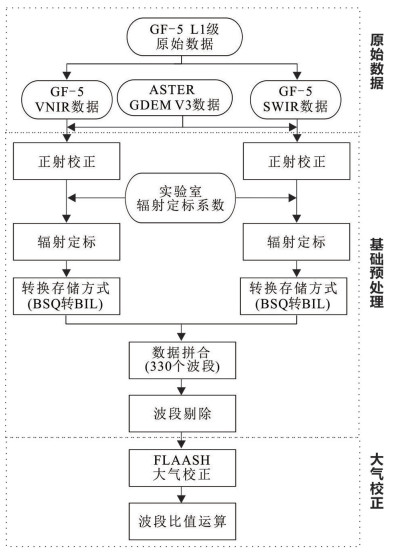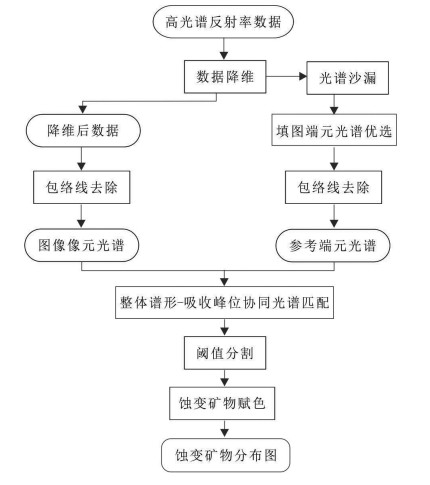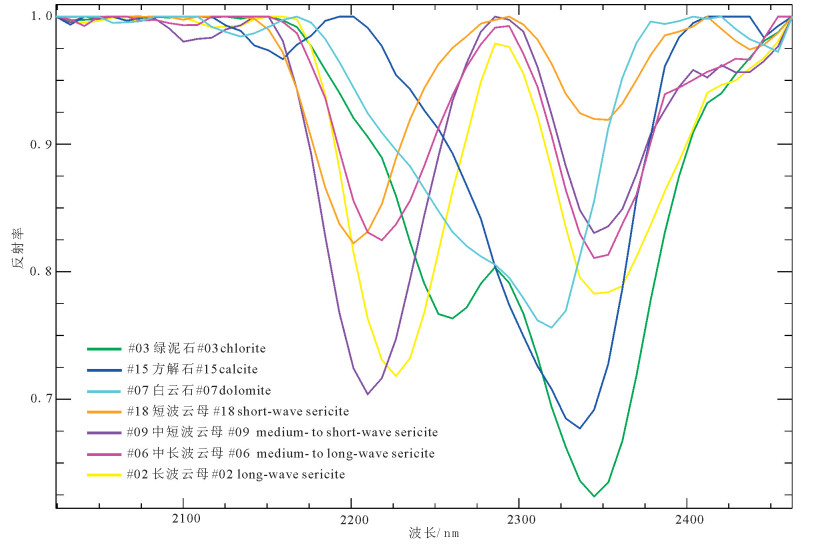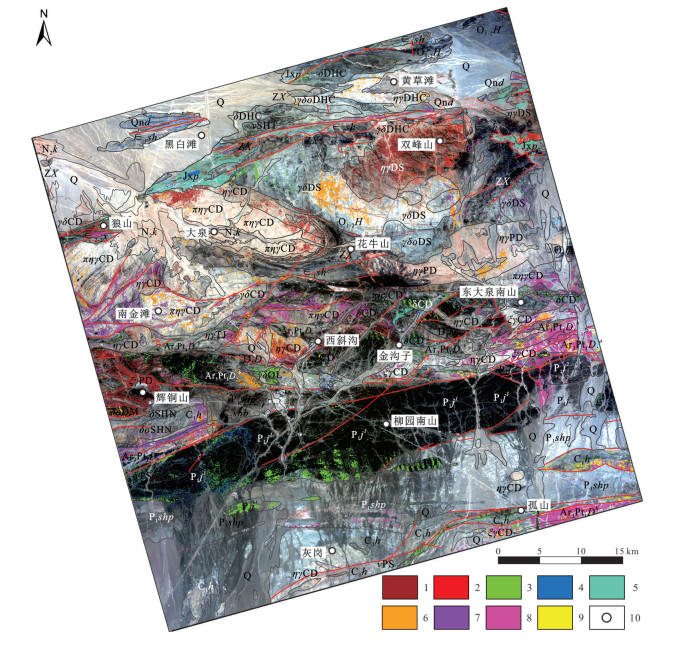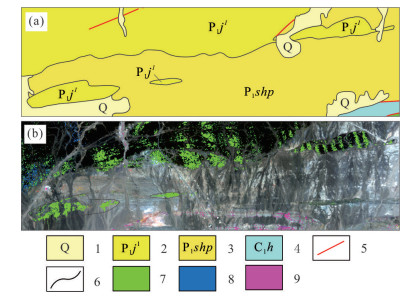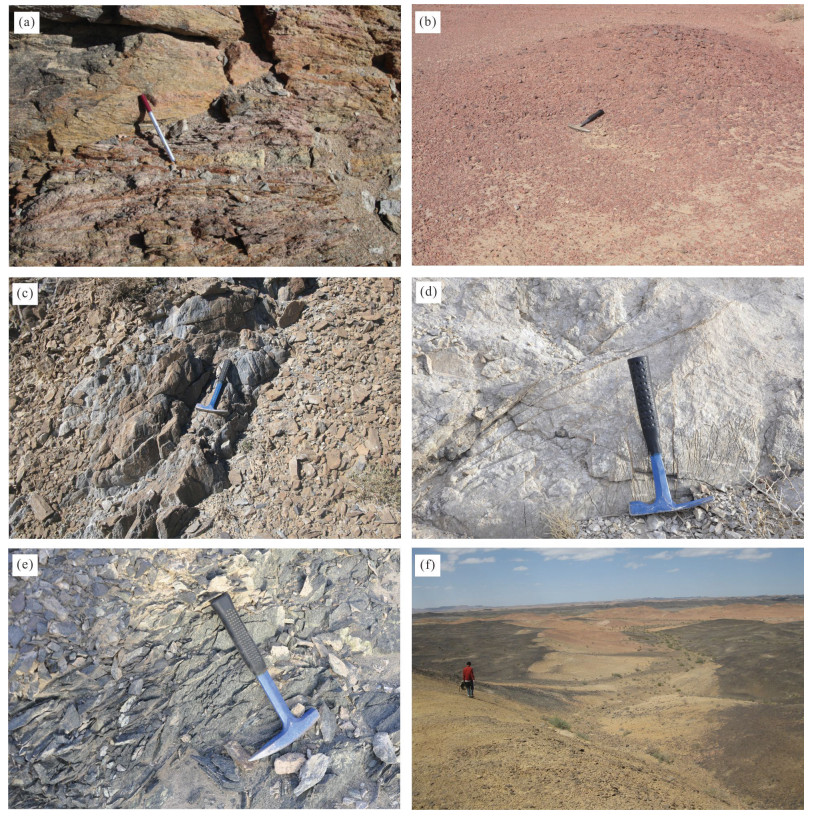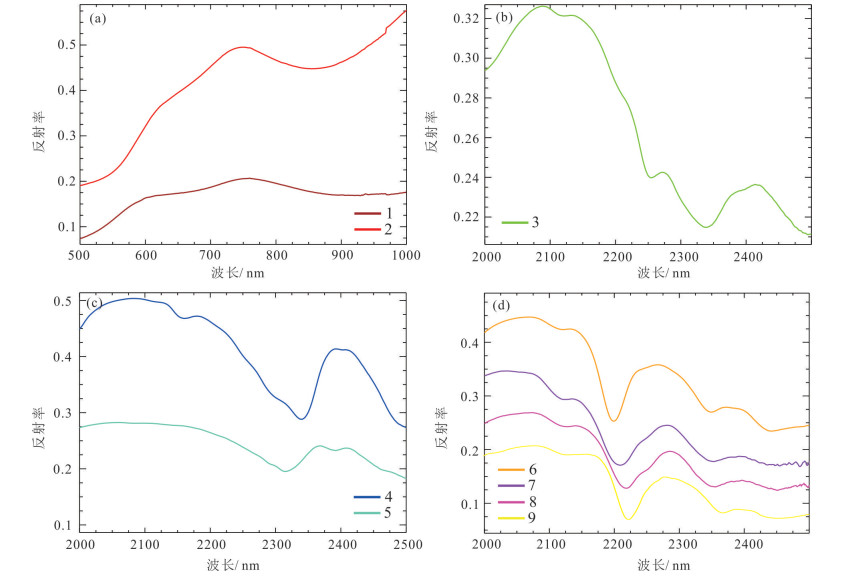Alteration mineral mapping based on the GF-5 hyperspectral data and its geological application——An example of the Huaniushan area in Guazhou County of Gansu Province
-
摘要:研究目的
“图谱合一”的GF-5 AHSI国产卫星高光谱数据可以根据光谱精细特征进行蚀变矿物的直接识别,一次过境成像即可获取宽幅大面积高光谱数据,能够为陆域自然资源调查提供重要的数据支撑,本文开展了GF-5高光谱数据蚀变矿物提取、分析与验证研究,以期推动国产卫星高光谱数据在地质领域的深化应用。
研究方法建立了GF-5高光谱数据预处理和蚀变矿物填图技术流程,在改进传统光谱角匹配算法基础上提出了一种整体谱形-吸收峰位协同的光谱匹配新方法,应用python语言开发了相应的算法模块,在甘肃省花牛山地区开展了矿物填图应用,综合分析了岩性-构造-蚀变多源地学要素,应用野外地质调查和ASD光谱测量方法对蚀变矿物提取结果进行了验证。
研究结果应用GF-5高光谱数据成功提取了花牛山地区的9种蚀变矿物,分别为褐铁矿、赤铁矿、绿泥石、方解石、白云石、短波云母、中短波云母、中长波云母、长波云母,编制了整景3600 km2的蚀变矿物分布图。该地区定向分布的白云石和方解石矿物反映了碳酸盐成分的沉积/变质地层的地表出露情况,绿泥石矿物揭示了富含角闪石矿物地质体的分布,褐铁矿和赤铁矿矿物反映了与酸性花岗岩有关的热液活动,短波云母主要分布在二长花岗岩体内,中短波云母反映了中酸性岩体与敦煌岩群老地层接触带等特殊构造部位的热液活动,中长波云母与北东向断裂构造关系密切,长波云母暗示存在早石炭世之前的热液活动。
结论GF-5高光谱数据能够提取褐铁矿等9种蚀变矿物,结果证实蚀变矿物填图结果可信。不同蚀变矿物在地质涵义方面存在较大差异,碳酸盐矿物与沉积/变质地层关系密切,云母矿物更多反映了与中酸性岩体及断裂构造有关的热液活动。本文认为GF-5高光谱数据可有效服务于地质体快速识别和界线修编、新鲜样品采样定位等自然资源领域基础地质调查和矿产地质勘查工作。
创新点: 提出了一种整体谱形-吸收峰位协同的高光谱数据光谱匹配新方法,首次进行了整景GF-5高光谱数据蚀变矿物的提取、综合分析和野外验证。
Abstract:This paper is the result of mineral exploration engineering.
ObjectiveThe GF-5 AHSI satellite hyperspectral data, featured by the integration of both image and spectrum, can be utilized to directly identify alteration minerals according to their fine spectral characteristics. Large-area wide-range hyperspectral data can be easily obtained by one transit imaging, which can well support the survey of land natural resources. This work extracted alteration minerals using the GF-5 hyperspectral data, and conducted further analysis and field verification, in an attempt to promote the deepening application of China's satellite hyperspectral data in geological field.
MethodsTechnical workflows of preprocessing GF-5 hyperspectral data and alteration mineral mapping were established. Based on the improvement of the traditional spectral angle matching algorithm, a new spectral matching method of the whole spectral shape synergy with absorption peak position was proposed, and the corresponding algorithm module with the Python language was developed. Taking the Huaniushan area of Gansu Province as an example, we conducted mineral mapping, and comprehensively analyzed multi-source geological elements including lithology, structure, and alteration. The extracted alteration minerals were then verified by field survey and ASD spectral measurements.
ResultsNine types of alteration minerals were successfully extracted using the GF-5 hyperspectral data, i.e., limonite, hematite, chlorite, calcite, dolomite, short-wave sericite, medium- to short-wave sericite, medium- to long-wave sericite and long-wave sericite, to describe the distribution of alteration minerals with an area of 3600 km2. The directionally distributed dolomite and calcite minerals reflect the surface exposure of sedimentary or metamorphic strata with carbonate composition. Chlorite minerals reveal the distribution of geological bodies rich in amphibole. Limonite and hematite minerals are indicative of the hydrothermal activities related to acid granites. Short-wave sericite was mainly distributed in the monzogranite. Medium- to short-wave sericite is suggestive of the hydrothermal activity of special structural section such as the contact zone between intermediate and acid rock masses and the old Dunhuang Complex. Medium- to long-wave sericite was closely related to the NE-trending fault. Long-wave sericite indicates the presence of hydrothermal activity before the Early Carboniferous.
ConclusionsThe GF-5 hyperspectral data can extract nine types of alteration minerals including limonite, and the field verification confirms the reliability of alteration mineral mapping. Different alteration minerals may be interpreted from varying aspects. Carbonate minerals are inferred to be closely related to sedimentary or metamorphic strata, while sericite minerals mostly reflect hydrothermal activities related to intermediate to acid rock mass and fault structure. It is considered that the GF-5 hyperspectral data can rapidly identify geological bodies, and can help to revise geological boundary and locate fresh samples, which will effectively serve the basic geological survey and mineral geological exploration in the field of natural resources.
-
1. 引言
成像高光谱遥感是当前遥感研究前沿之一,将成像技术与光谱技术结合可以获取完整连续的地物光谱曲线,实现根据光谱特征进行地物分类识别,在地质领域有许多成功应用案例。众多学者应用AVIRIS(甘甫平等,2003; Jain and Sharma, 2019; Kumar et al., 2020)、Hymap(Okyay and Khan, 2016; Salles et al., 2017; 孙永彬等,2018)、CASI/SASI/TASI(Cui et al., 2015; 刘德长等,2018; 叶发旺等,2018; 刘德长等,2019; Liu et al., 2021)等航空成像高光谱数据在岩性分类、蚀变矿物识别、热液矿产勘查等方面取得了一系列研究成果。此外,成像高光谱数据在地表尺度矿物类型识别(Kurz et al., 2008; 孙雨等,2015a; Sun et al., 2017)和岩心尺度蚀变分析(孙雨等,2015b; de Linaje et al., 2018; 张川等,2019)中也发挥了重要作用。然而,高光谱数据获取难度与高成本制约了技术的广泛应用(王润生等,2011)。
相比于昂贵且稀少的航空遥感数据(修连存等,2021),卫星遥感数据具有价格低廉、容易获取且覆盖面积大的特点,适合用于开展区域地质矿产调查应用研究(Wang et al., 2018)。当前,民用高光谱卫星数据主要是美国的Hyperion数据(Zhang et al., 2015; Hu et al., 2018)、中国的TG-1(Wu et al., 2014; 覃帮勇等,2018; )、GF-5数据(董新丰,2020; Ye et al., 2020)和ZY-02D数据。其中,GF-5卫星作为中国高分辨率对地观测重大科技专项中唯一的高光谱观测卫星,卫星上搭载的AHSI载荷自2018年5月9日成功发射以来已经获取大量的高光谱数据,为自然资源综合调查工作提供了重要的国产数据保障(刘银年,2020)。
在应用高光谱数据进行矿物识别方面,光谱角填图(Spectral Angle Mapper,SAM)算法因其简单高效而广泛应用(Kruse et al., 1993)。但是,传统SAM算法对所有波段一视同仁,赋予相同的权重因子,而地质事实是特定波段对于某类蚀变矿物具有重要意义。传统SAM算法对整体谱型敏感而对光谱曲线局部细节特征不敏感(陈亮等,2007),可以有效区分出云母和绿泥石等矿物大类,但对形态相似的光谱则区分度较低,难以精细区分矿物亚类(例如短波云母和长波云母)。
本文以甘肃省瓜州县花牛山地区的GF-5高光谱数据为例,构建了完整的GF-5数据标准预处理流程,针对传统SAM算法的缺陷开发了整体谱形-吸收峰位协同的光谱匹配算法,提取出了褐铁矿、绿泥石、方解石、短波云母等9种蚀变矿物,分析了蚀变矿物的地质分布特征,对蚀变矿物填图结果进行了实地验证,为GF-5高光谱数据大规模工程化应用奠定了基础。
2. 地质背景
花牛山研究区距离瓜州县城西北方向约80 km,行政区划上隶属于甘肃省西北部的酒泉市瓜州县(图 1a)。研究区地表植被稀少,基岩裸露程度高,地质构造影像特征清晰,不同岩性色调差异明显,多种类型蚀变发育(吕新彪等,2012),十分有利于开展遥感地质研究(图 1b)。
研究区的大地构造分区位置为塔里木板块的北山地块,地跨双鹰山早古生代裂谷型被动陆缘带和北山晚古生代多旋回陆内裂谷带。地层方面,研究区主要分布古生界和前寒武系地层,其次为新近系和第四系(图 2)。第四系(Q)岩性为松散冲积、洪积砾石、砂土; 新近系苦泉组(N2k)岩性为桔红色灰质粉砂质泥岩夹砂砾岩; 下二叠统金塔组上段(P1j2)岩性为灰色粉砂岩、灰色安山质凝灰岩、灰色中粗粒变质砂岩夹板岩,下段(P1j1)岩性为灰色、灰绿色玄武岩; 下二叠统双堡塘组(P1shp)岩性为灰色及灰绿色板岩、灰色薄层变质砂岩; 上石炭统石板山组(C2shb)岩性为灰白-黄绿色砾岩、砂岩夹含砾结晶灰岩; 下石炭统红柳园组(C1h)岩性为块状安山岩、粉砂质板岩、砂岩夹千枚岩; 上泥盆统墩墩山群(D3D)岩性为粉红色流纹岩、浅灰色英安岩; 上奥陶统白云山组(O3b)岩性为灰绿色玄武岩、灰色英安岩、灰色细砾岩、细砂岩、粉砂岩; 中下奥陶统花牛山群(O1-2H)岩性为变质砂岩、角岩、灰绿色蚀变玄武岩、板岩、大理岩; 中上寒武统西双鹰山组(∈2-3x)岩性为灰色灰岩夹黑色硅质岩; 下寒武统双鹰山组(∈1sh)岩性为灰色粉砂岩、粉砂质板岩夹灰岩及硅质岩; 震旦系洗肠井群(ZX)岩性为灰色板岩、灰岩夹大理岩及大理岩化灰岩; 青白口系大豁落山组(Qnd)岩性为浅灰白色中厚层状白云岩夹少量薄层灰岩; 蓟县系平头山组(Jxp)岩性为灰白—浅灰色灰岩、白云岩、大理岩; 前长城系敦煌岩群上岩组(Ar3Pt1D.b)岩性为灰色片岩、石英岩、斜长角闪岩,下岩组(Ar3Pt1D.a)岩性为浅灰色片麻岩夹片岩、斜长角闪岩。
![]() 图 2 花牛山地区区域地质简图❶1—第四系; 2—苦泉组; 3—金塔组上段; 4—金塔组下段; 5—双堡塘组; 6—石板山组; 7—红柳园组; 8—墩墩山群; 9—白云石组; 10—花牛山群; 11—西双鹰山组; 12—双鹰山组; 13—洗肠井群; 14—大豁落山组; 15-平头山组; 16—敦煌岩群上岩组; 17—敦煌岩群下岩组; 18—金滩子二长花岗岩; 19—东大泉钾长花岗岩; 20—东大泉二长花岗岩; 21—十字黑山辉长岩; 22—大泉钾长花岗岩; 23—大泉二长花岗岩; 24-大泉似斑状二长花岗岩; 25—大泉花岗闪长岩; 26—大泉闪长岩; 27—双峰山二长花岗岩; 28—双峰山英云闪长岩; 29—双峰山花岗闪长岩; 30—明舒井石英闪长岩; 31—黄草滩二长花岗岩; 32—黄草滩英云闪长岩; 33—黄草滩花岗闪长岩; 34—黄草滩闪长岩; 35—辉铜山基性杂岩; 36-辉铜山南石英闪长岩; 37—辉铜山南闪长岩; 38—龙山花岗闪长岩; 39—断层; 40—整合地质界线; 41—不整合界线; 42—地名Figure 2. Regional geological sketch map of the Huaniushan area❶1-Quaternary; 2-Kuquan Formation; 3-Upper member of Jinta Formation; 4-Lower member of Jinta Formation; 5-Shuangbaotang Formation; 6-Shibanshan Formation; 7-Hongliuyuan Formation; 8-Dundunshan Group; 9-Baiyunshan Formation; 10-Huaniushan Group; 11-Xishuangyingshan Formation; 12- Shuangyingshan Formation; 13-Xichangjing Group; 14-Dahuoluoshan Formation; 15-Pingtoushan Formation; 16- Upper rock formation of Dunhuang rock group; 17-Lower rock formation of Dunhuang rock group; 18-Jintanzi monzogranite; 19-Dongdaquan moyite; 20-Dongdaquan monzogranite; 21-Shiziheishan gabbro; 22- Daquan moyite; 23-Daquan monzogranite; 24- Daquan porphyritic monzogranite; 25- Daquan granodiorite; 26-Daquan diorite; 27-Shuangfengshan monzogranite; 28-Shuangfengshan tonalite; 29-Shuangfengshan granodiorite; 30-Mingshujing quartz diorite; 31-Huangcaotan adamellite; 32-Huangcaotan tonalite; 33-Huangcaotan granodiorite; 34-Huangcaotan diorite; 35-Huitongshan basic complex; 36-Huitongshannan quartz diorite; 37- Huitongshannan diorite; 38-Longshan granodiorite; 39-Fault; 40-Conformable geological boundary; 41-Unconformable geological boundary; 42-Place name
图 2 花牛山地区区域地质简图❶1—第四系; 2—苦泉组; 3—金塔组上段; 4—金塔组下段; 5—双堡塘组; 6—石板山组; 7—红柳园组; 8—墩墩山群; 9—白云石组; 10—花牛山群; 11—西双鹰山组; 12—双鹰山组; 13—洗肠井群; 14—大豁落山组; 15-平头山组; 16—敦煌岩群上岩组; 17—敦煌岩群下岩组; 18—金滩子二长花岗岩; 19—东大泉钾长花岗岩; 20—东大泉二长花岗岩; 21—十字黑山辉长岩; 22—大泉钾长花岗岩; 23—大泉二长花岗岩; 24-大泉似斑状二长花岗岩; 25—大泉花岗闪长岩; 26—大泉闪长岩; 27—双峰山二长花岗岩; 28—双峰山英云闪长岩; 29—双峰山花岗闪长岩; 30—明舒井石英闪长岩; 31—黄草滩二长花岗岩; 32—黄草滩英云闪长岩; 33—黄草滩花岗闪长岩; 34—黄草滩闪长岩; 35—辉铜山基性杂岩; 36-辉铜山南石英闪长岩; 37—辉铜山南闪长岩; 38—龙山花岗闪长岩; 39—断层; 40—整合地质界线; 41—不整合界线; 42—地名Figure 2. Regional geological sketch map of the Huaniushan area❶1-Quaternary; 2-Kuquan Formation; 3-Upper member of Jinta Formation; 4-Lower member of Jinta Formation; 5-Shuangbaotang Formation; 6-Shibanshan Formation; 7-Hongliuyuan Formation; 8-Dundunshan Group; 9-Baiyunshan Formation; 10-Huaniushan Group; 11-Xishuangyingshan Formation; 12- Shuangyingshan Formation; 13-Xichangjing Group; 14-Dahuoluoshan Formation; 15-Pingtoushan Formation; 16- Upper rock formation of Dunhuang rock group; 17-Lower rock formation of Dunhuang rock group; 18-Jintanzi monzogranite; 19-Dongdaquan moyite; 20-Dongdaquan monzogranite; 21-Shiziheishan gabbro; 22- Daquan moyite; 23-Daquan monzogranite; 24- Daquan porphyritic monzogranite; 25- Daquan granodiorite; 26-Daquan diorite; 27-Shuangfengshan monzogranite; 28-Shuangfengshan tonalite; 29-Shuangfengshan granodiorite; 30-Mingshujing quartz diorite; 31-Huangcaotan adamellite; 32-Huangcaotan tonalite; 33-Huangcaotan granodiorite; 34-Huangcaotan diorite; 35-Huitongshan basic complex; 36-Huitongshannan quartz diorite; 37- Huitongshannan diorite; 38-Longshan granodiorite; 39-Fault; 40-Conformable geological boundary; 41-Unconformable geological boundary; 42-Place name岩浆岩方面,研究区岩浆活动频繁,产出基性—酸性不同类型岩石组合(图 2),在酸性花岗岩内发育一系列金矿(司学峰等,2000)。花牛山地区出露的印支期侵入岩为金滩子岩体(ηγTJ),海西期侵入岩包括东大泉岩体(ξγPD、ηγPD)、十字黑山岩体(νPS)、大泉岩体(ξγCD、ηγCD、πηγCD、γδCD、δCD)、双峰山岩体(ηγDS、γδοDS、γδDS)、明舒井岩体(δοDM),海西期侵入岩为黄草滩岩体(ηγDHC、γδοDHC、γδDHC、δDHC),加里东期侵入岩包括辉铜山基性杂岩体(νSHT)、辉铜山南岩体(δοSHN、δSHN)、龙山岩体(γδOL)。脉岩多为石英脉、闪长岩脉及辉绿岩脉。
构造方面,研究区主要的褶皱构造有花牛山背斜和柳园南山向斜,断裂构造的优势方位为北东东和北东向(图 2)。
3. 数据源及预处理
3.1 高光谱数据源
2018年5月9日2时28分,GF-5卫星在中国太原卫星发射中心成功发射。它是高分专项中一颗重要的科研卫星,是世界首颗实现对大气和陆地综合观测的全谱段高光谱卫星,是中国实现高光谱分辨率对地观测能力的重要标志。GF-5卫星轨道高度为705 km,搭载的可见短波红外高光谱相机可获取幅宽60 km、空间分辨率30 m的高光谱数据(GF-5 AHSI)。
本次工作选用2018年8月7日获取的GF-5 AHSI高光谱数据,产品级别为L1级,产品号为L10000055485。高光谱数据包含可见-近红外数据(VNIR)和短波红外数据(SWIR)共两个GeoTiff文件,并均有与之对应的RPB文件。主要参数详见表 1。
表 1 GF-5 AHSI高光谱数据主要参数一览Table 1. Main parameters of the GF-5 AHSI hyperspectral data
3.2 高光谱数据预处理
GF-5高光谱数据预处理是将L1级原始数据转换为高光谱反射率数据,为蚀变单矿物提取和制图提供数据支撑。GF-5高光谱数据预处理由基础预处理和大气校正处理两部分构成,详细步骤如图 3所示。
3.2.1 高光谱数据基础预处理
GF-5高光谱数据基础预处理主要包括正射校正、辐射定标、转换存储方式、数据拼合、波段剔除处理。正射校正处理是利用高光谱数据自带的RPC文件参数,基于最新的ASTER GDEM V3高程数据(空间分辨率30 m)进行几何校正以消除地形的影响,得到具有UTM-WGS84投影坐标系统的高光谱数据。辐射定标处理是基于原始数据自带的实验室定标系数(增益Gain和偏移Offset)进行定标,得到具有物理意义的辐射亮度数据。然后,通过存储方式转换,将BSQ数据转换成BIL数据,再将VNIR和SWIR数据拼合成一个整体数据(共330个波段)。通过波段剔除,去除水汽吸收波段(无数据)、低信噪比波段和探测器范围重合波段(表 2),最终获得包含238个波段的高光谱数据。
表 2 GF-5高光谱数据剔除波段一览Table 2. Eliminated bands of GF-5 hyperspectral data
3.2.2 大气校正
本文采用基于大气辐射传输模型的方法开展大气校正,具体是应用ENVI 5.3中FLAASH模块,设置大气校正需要的各种参数信息(表 3),通过大气校正得到放大10000倍的反射率数据。然后,应用波段比值运算进行缩放,并进行必要的光谱圆滑处理,得到数值范围在0~1.0的高光谱反射率数据,为矿物填图奠定基础。
表 3 GF-5高光谱数据大气校正参数一览Table 3. Atmospheric correction parameters of GF-5 hyperspectral data
4. 蚀变矿物填图
4.1 高光谱矿物填图技术流程
在高光谱数据预处理后,应用反射率数据进行矿物填图,其技术流程如图 4所示。首先,进行数据降维并进行光谱沙漏处理,并对获得的矿物填图端元光谱进行优选。然后,对降维后的高光谱数据和填图端元光谱均进行包络线去除,采用整体谱形-吸收峰位协同光谱匹配算法,逐个像元计算图像像元光谱与参考端元光谱的匹配度。最后,进行矿物识别匹配度阈值分割并赋色,得到蚀变矿物分布图。
4.2 高光谱数据降维处理
高光谱数据具有上百个波段,如果全部参与预算则数据量巨大,而且蚀变矿物不是在所有波段均匀分布的,因此有必要进行高光谱数据降维(郑向涛,2017),使矿物特征更加集中。高光谱数据降维实现是采用波段筛选的方式,有针对性的挑选出对蚀变矿物敏感的谱段范围。蚀变矿物光谱吸收机理是金属阳离子在可将光区域的电子过程和阴离子集团在短波红外区域的振动过程(燕守勋等,2003),具体表现为VNIR谱段的褐铁矿/赤铁矿/孔雀石等含铁、铜离子的矿物及萤石等具色心的矿物,吸收谱带集中在502~998 nm(band 25~band 141);以及SWIR谱段的绢云母/伊利石/高岭石等含铝羟基的矿物、绿泥石/绿帘石等含镁羟基的矿物、方解石/白云石等含碳酸根的矿物等,吸收谱带集中在2024~2463 nm。降维处理后得到波段筛选后的VNIR数据和SWIR数据。
4.3 填图端元光谱优选
填图光谱端元的选择是高光谱矿物识别中的重要环节。本文应用降维后的VNIR数据和SWIR数据,使用ENVI软件中内置的光谱沙漏(Spectral Hourglass)算法(李光辉等,2013)。首先进行最小噪声分离,随后根据纯净像元指数提取纯净像元并投影到N维可视化空间进行分析后,得到高光谱数图像端元候选光谱。
根据专家知识,综合应用光谱整体形态和光谱吸收位置特征(吸收峰所处波长位置、数量和主次关系等),对候选端元光谱逐一进行检查,优选出具有明确地质意义的蚀变矿物端元光谱。
在可见近红外(VNIR)谱段,得到了褐铁矿、赤铁矿的图像端元光谱,在短波红外(SWIR)谱段,共得到7类蚀变矿物的图像端元光谱,分别为绿泥石、方解石、白云石、短波云母、中短波云母、中长波云母、长波云母。
4.4 包络线去除
反射光谱曲线可视为由各个单独吸收特征叠加在包络线背景光谱上形成的。包络线去除(Clark and Roush, 1984)处理就是将原始光谱与包络线光谱相除,从而减弱不同光照条件下反射率强度差异,凸显不同蚀变矿物的吸收和反射特征,在此基础上提取更准确的典型吸收特征(van der Meer,2000)。
本文对数据降维后高光谱数据和光谱沙漏后优选出的蚀变矿物端元光谱均进行包络线去除,为光谱匹配奠定基础。经过包络线去除后,优选出的蚀变矿物图像端元光谱的主、次吸收位置更加明显,可以更有效的识别蚀变矿物。以短波红外(SWIR)谱段为例,各蚀变矿物图像端元光谱进行包络线去除后的光谱曲线如图 5所示。
绿泥石端元光谱展现出清晰地双吸收特征,第一特征吸收峰位于2345 nm,第二特征吸收峰位于2260 nm。方解石端元光谱也存在明显的双吸收特征,第一特征吸收峰位于2336 nm,第二特征吸收峰位于2159 nm。白云石端元光谱只有一个吸收峰,位于2319 nm。短波云母端元光谱展现出清晰地双吸收特征,第一特征吸收峰位于2201 nm,第二特征吸收峰位于2345 nm附近; 中短波云母端元光谱第一特征吸收峰位于2210 nm,第二吸收峰位于2345 nm附近; 中长波云母端元光谱第一特征吸收峰位于2218 nm,第二吸收峰位于2345 nm附近; 长波云母端元光谱第一特征吸收峰位于2226 nm,第二吸收峰位于2345 nm附近。
4.5 整体谱形-吸收峰位协同光谱匹配
将光谱沙漏处理得到图像端元光谱进行优选,并进行包络线去除,得到蚀变矿物的参考光谱,以包络线去除后的图像像元光谱为待匹配光谱,二者均可视为高维空间向量。添加必要的整体谱形-吸收峰位协同判别条件,逐像元计算待匹配光谱与参考光谱的相似度,进行阈值分割并对蚀变矿物赋色,最终得到蚀变单矿物分布图。
以短波云母为例,整体谱形-吸收峰位协同的判别规则如下:
(1) 逐波段比较反射率数值,在2201 nm处和[2336 nm,2353 nm]谱段范围内存在局部反射率最小值;
(2) 2201 nm处反射率数值小于[2336 nm,2353 nm]谱段范围局部反射率最小值;
(3) 待匹配光谱与参考光谱向量夹角θ的反余弦弧度值arccosθ<0.1。
其他蚀变矿物的整体谱形-吸收峰位协同判别规则与之类似。应用当前热门的python编程语言,基于上述原理开发了整体谱形-峰位协同光谱匹配算法模块,可以批量进行GF-5高光谱数据处理。
5. 结果与讨论
采用本次研究提出的整体谱形-吸收峰位协同光谱匹配算法,应用GF-5高光谱数据提取了褐铁矿、赤铁矿、绿泥石、方解石、白云石、短波云母、中短波云母、中长波云母、长波云母共9种蚀变矿物。选择作为R=639 nm、G=549 nm、B=459 nm作为真彩色合成波段,制作研究区真彩色影像。在此基础上,将各种蚀变矿物赋予特定颜色后叠加到真彩色影像图上,得到花牛山地区高光谱蚀变矿物分布图(图 6)。同时,采用多源地学信息复合方法,以地理坐标为纽带,将高光谱蚀变矿物与基础地质岩性、断裂构造和真彩色影像叠合,编制了研究区岩性-构造-蚀变多源地学信息综合图(图 7)。
![]() 图 6 花牛山地区高光谱蚀变矿物分布图1—褐铁矿; 2—赤铁矿; 3—绿泥石; 4—方解石; 5—白云石; 6—短波云母; 7—中短波云母; 8—中长波云母; 9—长波云母; 10—野外验证点; 11—地名Figure 6. Map showing distribution of alteration minerals extracted from hyperspectral data in the Huaniushan area1-Limonite; 2-Hematite; 3-Chlorite; 4-Calcite; 5-Dolomite; 6-Short-wave sericite; 7-Medium- to short-wave sericitemica; 8-Medium- to long-wave sericite; 9-Long-wave sericite; 10-Field verification point; 11-Place name
图 6 花牛山地区高光谱蚀变矿物分布图1—褐铁矿; 2—赤铁矿; 3—绿泥石; 4—方解石; 5—白云石; 6—短波云母; 7—中短波云母; 8—中长波云母; 9—长波云母; 10—野外验证点; 11—地名Figure 6. Map showing distribution of alteration minerals extracted from hyperspectral data in the Huaniushan area1-Limonite; 2-Hematite; 3-Chlorite; 4-Calcite; 5-Dolomite; 6-Short-wave sericite; 7-Medium- to short-wave sericitemica; 8-Medium- to long-wave sericite; 9-Long-wave sericite; 10-Field verification point; 11-Place name![]() 图 7 花牛山地区岩性-构造-蚀变多源地学信息综合图1—褐铁矿; 2—赤铁矿; 3—绿泥石; 4—方解石; 5—白云石; 6—短波云母; 7—中短波云母; 8—中长波云母; 9—长波云母; 10—地名; 其他地质符号含义同图 2Figure 7. Multi-source geoscience information of lithology, structure and alteration in the Huaniushan area1-Limonite; 2-Hematite; 3-Chlorite; 4-Calcite; 5-Dolomite; 6-Short-wave sericite; 7-Medium- to short-wave sericite; 8-Medium- to long-wave sericite; 9-Long-wave sericite; 10-Place name; Meanings of other geological symbols are the same as those in Fig. 2
图 7 花牛山地区岩性-构造-蚀变多源地学信息综合图1—褐铁矿; 2—赤铁矿; 3—绿泥石; 4—方解石; 5—白云石; 6—短波云母; 7—中短波云母; 8—中长波云母; 9—长波云母; 10—地名; 其他地质符号含义同图 2Figure 7. Multi-source geoscience information of lithology, structure and alteration in the Huaniushan area1-Limonite; 2-Hematite; 3-Chlorite; 4-Calcite; 5-Dolomite; 6-Short-wave sericite; 7-Medium- to short-wave sericite; 8-Medium- to long-wave sericite; 9-Long-wave sericite; 10-Place name; Meanings of other geological symbols are the same as those in Fig. 25.1 蚀变矿物与岩性-构造的关系
GF-5高光谱数据提取的褐铁矿和赤铁矿矿物(图 7)在双峰山地段呈团块状分布,严格产出于泥盆纪双峰山二长花岗岩(ηγDS)界线内。高光谱提取的蚀变矿物反映该岩体西部与东部蚀变类型不同,西部主要为褐铁矿蚀变,岩石为褐红色; 东部主要为赤铁矿蚀变,岩石呈褐黄色。大泉地段的褐铁矿呈弥散状分布在石炭纪大泉二长花岗岩(ηγCD)/似斑状二长花岗岩体(πηγCD)的西北部和东部,而岩体内部和西南部则极少有褐铁矿,表明蚀变程度在岩体的不同部位存在很大差异,高光谱数据提取的蚀变可以直接揭示地质体不同地段的蚀变发育程度。花牛山地段的褐铁矿和赤铁矿呈细脉状、条带状展布,并不是在岩体各个部位都有,而是仅分布在二叠纪东大泉二长花岗岩体(ηγPD)的岩枝上或岩枝附近,表明在这些构造特殊部位发生了热液蚀变作用。辉铜山地段的褐铁矿呈弥散状分布在二叠纪东大泉钾长花岗岩(ξγPD)及石炭纪大泉二长花岗岩体(ηγCD)内,反映的是全岩蚀变。西斜沟以西地段为褐铁矿,呈团块状分布在石炭纪大泉二长花岗岩体(ηγCD)内; 西斜沟以东地段为赤铁矿,呈宽带状分布在泥盆系墩墩山群地层(D3D)内,反映的是流纹岩等酸性喷出岩发生的蚀变。综上可知,褐铁矿、赤铁矿矿物主要分布在泥盆纪—二叠纪的二长花岗岩及泥盆系墩墩山群地层内,反映了与酸性花岗岩有关的热液活动。褐铁矿和赤铁矿矿物在空间位置上与断裂构造距离较远,在分布形态上很少呈线状定向展布,受断裂构造控制特征不明显,总体而言与断裂关系不大。
绿泥石矿物(图 7)在黑白滩东地段呈小团块状分布在泥盆纪双峰山花岗闪长岩体(γδDS)西北的局部地段,由岩石中富集的角闪石矿物发生热液蚀变而成。东大泉南山—金沟子地段的绿泥石呈斑块状分布在石炭纪大泉闪长岩体(δCD)及前长城系敦煌岩群上岩组(Ar3Pt1D.b)的局部地段,由闪长岩和敦煌岩群中斜长角闪岩中角闪石发生蚀变形成,反映了斜长角闪岩段的出露范围及闪长岩中富角闪石地段。辉铜山地段的绿泥石呈斑块状分布在志留纪辉铜山基性杂岩体(νSHT)和奥陶纪龙山花岗闪长岩体内局部地段,二者均富含角闪石矿物,岩石中的角闪石矿物在热液作用下形成绿泥石。柳园南山地段的绿泥石大部分呈透镜体状、条带状分布在二叠系金塔组下段(P1j1)地层的局部地段,聚集产出于灰岗以北地段,与之相对应的孤山以北地段则基本未见绿泥石,反映了该期热液活动不是区域性变质热液,而是局部性热液活动。值得注意的是,该地段3块透镜状的金塔组下段地层周围均是二叠系双堡塘组(P1shp)地层,绿泥石严格限定在金塔组下段地层内,绿泥石分布外轮廓线反映了金塔组下段地层界线(图 8)。孤山地段的绿泥石呈脉状分布在二叠纪十字黑山辉长岩体(νPS)内,明显为辉长岩中辉石蚀变成绿泥石的结果。综上可知,绿泥石矿物主要分布在泥盆纪—石炭纪闪长岩及花岗闪长岩、志留纪—二叠纪基性岩体和前长城系敦煌岩群上岩组、二叠系金塔组下段内,是由岩石中的角闪石矿物在热液作用下蚀变而成。绿泥石矿物较少出现线状定向分布,总体上受断裂构造控制特征不明显。
![]() 图 8 花牛山地区二叠系金塔组地层中的绿泥石矿物及岩性分布图1—第四系; 2—金塔组下段; 3—双堡塘组; 4—红柳园组; 5—断层; 6—整合地质界线; 7—绿泥石; 8—方解石; 9—中长波云母Figure 8. Distribution map of the chlorite alteration mineral and the lithology in Permian Jinta Formation1-Quaternary; 2-Lower member of Jinta Formation; 3-Shuangbaotang Formation; 4-Hongliuyuan Formation; 5-Fault; 6-Conformable geological boundary; 7-Chlorite; 8-Calcite; 9-Long-wave sericite
图 8 花牛山地区二叠系金塔组地层中的绿泥石矿物及岩性分布图1—第四系; 2—金塔组下段; 3—双堡塘组; 4—红柳园组; 5—断层; 6—整合地质界线; 7—绿泥石; 8—方解石; 9—中长波云母Figure 8. Distribution map of the chlorite alteration mineral and the lithology in Permian Jinta Formation1-Quaternary; 2-Lower member of Jinta Formation; 3-Shuangbaotang Formation; 4-Hongliuyuan Formation; 5-Fault; 6-Conformable geological boundary; 7-Chlorite; 8-Calcite; 9-Long-wave sericite方解石在黑白滩以西地段呈细条带状分布在青白口系大豁落山组(Qnd)和寒武系双鹰山组(∈1sh)地层内。黑白滩以东地段的方解石和白云石呈细条带状分布在蓟县系平头山组(Jxp)地层内,白云石分布范围更广,局部分布方解石。白云石和方解石矿物分布情况表明该处地质图上的地层的边界不准确,本文根据白云石和方解石矿物分布情况,对地质界线进行了修编(图 9): 一是西部前人圈定为泥盆纪花岗闪长岩小岩体内出现较多的方解石矿物,结合影像色调和纹理特征,因此将该处岩体修编为平头山组地层; 二是东北部的震旦系洗肠井群(ZX)西边界附近出现了较多方解石矿物,而该地层在其他地段未见方解石,因此对洗肠井群西边界进行了修改。双峰山以西地段的白云石呈团块状分布在蓟县系平头山组(Jxp)地层推覆体内,双峰山以东地段的白云石呈团块状分布在大豁落山组(Qnd)和平头山组(Jxp)地层内,表明该处岩性主要为白云岩及白云质大理岩。金沟子以北地段以白云石为主,少量为方解石,均分布在前长城系敦煌岩群上岩组(Ar3Pt1D.b)内。柳园南山以西地段的方解石呈斑点状分布在二叠系金塔组下段(P1j1)内,不同地段蚀变发育情况迥异,主要分布在辉铜山南部,与绿泥石空间上伴生,均属于玄武岩的中温热液作用产物。综上可知,方解石和白云石矿物主要分布在前寒武系(敦煌岩群上岩组、平头山组、大豁落山组)、二叠系金塔组下段及寒武系双鹰山组中,前寒武系以白云石为主,金塔组下段地层和双鹰山组以方解石为主。方解石和白云石矿物与地层中富钙、镁质碳酸盐的灰岩/白云岩/大理岩关系密切,细条带状、条带状分布的方解石可以直观清晰的展示出层状碳酸盐岩石的地表出露界线。方解石和白云石矿物在分布形态上呈现受层理或面理控制的线状定向展布,但与断裂构造关系不大。
![]() 图 9 花牛山地区黑白滩地段蓟县系平头山组地质界线修编图1—第四系; 2—双鹰山组; 3—洗肠井群; 4—平头山组; 5—大泉二长花岗岩; 6—大泉似斑状二长花岗岩; 7—双峰山花岗闪长岩; 8—黄草滩闪长岩; 9—白云石; 10—方解石; 11—褐铁矿; 12—绿泥石; 13—断层; 14—修编前地质界线; 15—修编后地质界线Figure 9. Revised geological boundary of Pingtoushan Formation of Jixian System at the Heibaitan section in the Huaniushan area1-Quaternary; 2-Shuangyingshan Formation; 3-Xichangjing Group; 4-Pingtoushan Formation; 5-Daquan monzogranite; 6-Daquan porphyritic monzogranite; 7-Shuangfengshan granodiorite; 8-Huitongshannan diorite; 9-Dolomite; 10-Calcite; 11-Limonite; 12-Chlorite; 13-Fault; 14-Original geological boundary; 15-Revised geological boundary
图 9 花牛山地区黑白滩地段蓟县系平头山组地质界线修编图1—第四系; 2—双鹰山组; 3—洗肠井群; 4—平头山组; 5—大泉二长花岗岩; 6—大泉似斑状二长花岗岩; 7—双峰山花岗闪长岩; 8—黄草滩闪长岩; 9—白云石; 10—方解石; 11—褐铁矿; 12—绿泥石; 13—断层; 14—修编前地质界线; 15—修编后地质界线Figure 9. Revised geological boundary of Pingtoushan Formation of Jixian System at the Heibaitan section in the Huaniushan area1-Quaternary; 2-Shuangyingshan Formation; 3-Xichangjing Group; 4-Pingtoushan Formation; 5-Daquan monzogranite; 6-Daquan porphyritic monzogranite; 7-Shuangfengshan granodiorite; 8-Huitongshannan diorite; 9-Dolomite; 10-Calcite; 11-Limonite; 12-Chlorite; 13-Fault; 14-Original geological boundary; 15-Revised geological boundary泥盆纪黄草滩岩体的短波云母矿物呈团块状不均匀的分布在二长花岗岩体(ηγDHC)内,中短波云母和中长波云母呈细脉状定向分布在花岗闪长岩体(γδDHC)内。泥盆纪双峰山岩体的短波云母呈团块状不均匀分布在西南部的二长花岗岩体(ηγDS)内,中短波云母呈脉状、斑块状分布在东南部的二长花岗岩体(ηγDS)内。石炭纪大泉岩体在狼山地段的中长波云母呈密集团块状分布在花岗闪长岩体(γδCD)内; 大泉地段的短波云母呈斑块状分布在二长花岗岩(ηγCD)及似斑状二长花岗岩体(πηγCD)内,特别是岩枝部位蚀变强烈; 南金滩地段的短波云母呈团块状、中短波云母和中长波云母呈脉状分布在似斑状二长花岗岩体(πηγCD)内,长波云母呈条带状分布在岩体内北东向断裂构造附近; 西斜沟地段的短波云母呈团块状、中短波云母和中长波云母呈斑块状分布在二长花岗岩(ηγCD)、似斑状二长花岗岩体(πηγCD)和前长城系敦煌岩群上岩组(Ar3Pt1D.b)地层内,长波云母呈条带状分布在地层与岩体界线的北东向断裂构造附近; 金沟子地段的中短波云母和中长波云母呈条带状分布在钾长花岗岩体(ξγCD)、二长花岗岩体(ηγCD)及闪长岩体(δCD)内; 东大泉南山地段的短波云母呈团块状分布在闪长岩体(δCD)内,中短波云母和中长波云母呈斑块状、带状分布在钾长花岗岩体(ξγCD)、二长花岗岩(ηγCD)、似斑状二长花岗岩体(πηγCD)和前长城系敦煌岩群(Ar3Pt1D.a、Ar3Pt1D.b)地层内,长波云母呈团块状分布在前长城系敦煌岩群地层内。二叠纪东大泉岩体的短波云母呈团块状分布在二长花岗岩体(ηγPD)内,泥盆纪明舒井岩体的长波云母呈斑点状分布在石英闪长岩体(δοDM)内。志留纪辉铜山南岩体的短波云母呈团块状分布在闪长岩体(δSHN)和石英闪长岩体(δοSHN)及石炭系内,中短波云母呈细带状分布在闪长岩体(δSHN)和石英闪长岩体(δοSHN)及前长城系敦煌岩群地层内。在孤山地段,中长波云母呈带状及团块状、长波云母呈细条带状及透镜状分布在前长城系敦煌岩群上岩组(Ar3Pt1D.b)和下石炭统红柳园组(C1h)地层内。综上可知,短波云母主要分布在二长花岗岩体内且与断裂构造关系不大,中短波云母与断裂构造、中酸性岩体与敦煌岩群老地层接触带等特殊构造部位的热液活动关系密切,中长波云母与断裂构造特别是北东向断裂构造关系密切,长波云母为一期不晚于早石炭世的热液活动产物,时代上早于普遍发育在酸性花岗岩体的热液活动。
5.2 蚀变矿物地质验证
针对花牛山地区高光谱蚀变填图结果,选择典型地段部署了18个野外验证点(图 6),综合采用野外地质调查、室内岩矿鉴定和地面ASD光谱测量,对提取的蚀变矿物类型进行了综合验证。
验证点野外实地照片如图 10所示。褐铁矿化蚀变岩为褐黄色、褐红色,褐铁矿呈宽度数毫米到数厘米的脉状产出(图 10a)。赤铁矿化蚀变岩为灰红色,表现为地表一定面积的全岩蚀变(图 10b)。方解石化蚀变岩为深灰色-浅灰色,未发生大理岩化变质重结晶作用则为微晶结构,发生重结晶作用后多呈细粒结构,地表风化后呈褐黄色(图 10c)。白云石化蚀变岩为浅灰色白色,岩石较坚硬,风化可见刀砍纹(图 10d)。绿泥石化蚀变岩为浅灰绿色,原岩多为灰色-深灰色,远景多表现为整体灰色背景中的局部绿色带(图 10e)。绢云母化蚀变岩可为褐黄色,与浅灰色、肉红色中酸性岩原岩颜色上有差异(图 10f)。绢云母矿物多肉眼难以辨别,需要辅以ASD光谱测量才能精确判别具体的绢云母化类型。
![]() 图 10 花牛山地区蚀变岩野外照片a—褐铁矿化蚀变岩; b—赤铁矿化蚀变岩; c—方解石化蚀变岩; d—白云石化蚀变岩; e—绿泥石化蚀变岩; f—绢云母化蚀变岩Figure 10. Field photos of alteredrocks inthe Huaniushan areaa-Limonitized altered rock; b-Altered rock with hematitization; c-Altered rock with calcitization; d-Dolomitized altered rock; e-Chloritized altered rock; f-Sericitized altered rock
图 10 花牛山地区蚀变岩野外照片a—褐铁矿化蚀变岩; b—赤铁矿化蚀变岩; c—方解石化蚀变岩; d—白云石化蚀变岩; e—绿泥石化蚀变岩; f—绢云母化蚀变岩Figure 10. Field photos of alteredrocks inthe Huaniushan areaa-Limonitized altered rock; b-Altered rock with hematitization; c-Altered rock with calcitization; d-Dolomitized altered rock; e-Chloritized altered rock; f-Sericitized altered rock蚀变验证点的ASD实测光谱如图 11所示。褐铁矿实测光谱表现为反射率在600~750 nm范围的平缓上升,在950 nm附近存在宽缓吸收峰; 赤铁矿实测光谱表现为反射率在600~750 nm范围的坡度约45°的陡立上升,在870 nm附近存在宽缓吸收峰(图 11a)。绿泥石实测光谱第一吸收峰位于2345 nm附近,第二吸收峰位于2260 nm附近(图 11b)。方解石实测光谱第一吸收峰位于2336 nm附近,第二吸收峰位于2160 nm附近; 实测白云石存在2320 nm附近的吸收峰(图 11c)。实测云母类矿物光谱均具有2350 nm附近的第二吸收峰,只是第一吸收峰有所不同。短波云母位于2200 nm附近,中短波云母位于2208 nm附近,中长波云母位于2217 nm附近,长波云母位于2223 nm附近(图 11d)。
![]() 图 11 花牛山地区蚀变矿物实测光谱曲线图1—褐铁矿; 2—赤铁矿; 3—绿泥石; 4—方解石; 5—白云石; 6—短波云母; 7—中短波云母; 8—中长波云母; 9—长波云母Figure 11. Field measured spectra of alteration minerals in the Huaniushan area1-Limonite; 2-Hematite; 3-Chlorite; 4-Calcite; 5-Dolomite; 6-Short-wave sericite; 7-Medium- to short-wave sericite; 8-Medium-to long-wave sericite; 9-Long-wave sericite
图 11 花牛山地区蚀变矿物实测光谱曲线图1—褐铁矿; 2—赤铁矿; 3—绿泥石; 4—方解石; 5—白云石; 6—短波云母; 7—中短波云母; 8—中长波云母; 9—长波云母Figure 11. Field measured spectra of alteration minerals in the Huaniushan area1-Limonite; 2-Hematite; 3-Chlorite; 4-Calcite; 5-Dolomite; 6-Short-wave sericite; 7-Medium- to short-wave sericite; 8-Medium-to long-wave sericite; 9-Long-wave sericite对照USGS标准光谱库中褐铁矿、绿泥石、方解石、绢云母等蚀变矿物的光谱曲线,本次GF-5高光谱数据提取的蚀变矿物在野外光谱实测中均存在,而且实测光谱所属的矿物类型与矿物填图的矿物类型吻合,证实矿物填图的结果真实可信。
6. 结论
(1) 本文建立了完整的GF-5卫星高光谱数据预处理和矿物填图流程,提出了一种整体谱形-吸收峰位协同的光谱匹配新方法并应用python语言开发了相应的算法模块,在甘肃花牛山地区成功提取出了褐铁矿、赤铁矿、绿泥石、方解石、白云石、短波云母、中短波云母、中长波云母、长波云母共9种蚀变矿物。
(2) GF-5高光谱数据在花牛山地区提取的白云石矿物多分布在大豁落山组等前寒武系地层内,方解石则分布在金塔组下段地层内,二者与地层中富钙、镁质碳酸盐的灰岩/白云岩/大理岩关系密切,受层理或面理控制的细条带状、条带状定向展布的白云石和方解石矿物能直观清晰的展示出碳酸盐成分岩石在地表的出露情况。绿泥石矿物揭示了泥盆—石炭纪闪长岩、志留—二叠纪基性岩体等中基性岩体和前长城系敦煌岩群上岩组、二叠系金塔组下段地层等富含角闪石矿物地质体的分布情况。褐铁矿、赤铁矿矿物主要分布在泥盆纪—二叠纪的二长花岗岩及泥盆系墩墩山群地层内,反映了与酸性花岗岩有关的热液活动。短波云母主要分布在二长花岗岩体内,中短波云母反映了中酸性岩体与敦煌岩群老地层接触带等特殊构造部位的热液活动,中长波云母与北东向断裂构造关系密切,长波云母暗示存在早石炭世之前的热液活动,比酸性花岗岩体普遍存在的热液活动时代更老。
(3) 高光谱遥感提取的蚀变矿物揭示了原岩与热液的相互作用,白云石、方解石和绿泥石蚀变矿物侧重反映了地质体的原岩物质成分,而褐铁矿、赤铁矿和短波云母等云母类矿物反映了热液造成的蚀变物质记录。1景GF-5数据就可提供近3600 km2的多种类型蚀变矿物的宏观分布情况,可以为地质体识别与地质界线修编、新鲜样品采样定位等工作提供重要的遥感判据信息,有效服务于自然资源领域基础地质调查和矿产地质勘查。
注释
❶崔继岗, 王满仓, 赵鹏彬, 张继军, 代新宇, 唐力, 袁璋, 卢俊. 2014. 星星峡幅K46C003004 1/25万区域地质调查修测报告[R]. 陕西省地质调查院, 1-452.
致谢: 感谢中国资源卫星应用中心提供高光谱数据,张东辉高级工程师、刘鹏飞工程师等在野外验证中的帮助以及论文评审专家对本文提出的宝贵意见。 -
图 2 花牛山地区区域地质简图❶
1—第四系; 2—苦泉组; 3—金塔组上段; 4—金塔组下段; 5—双堡塘组; 6—石板山组; 7—红柳园组; 8—墩墩山群; 9—白云石组; 10—花牛山群; 11—西双鹰山组; 12—双鹰山组; 13—洗肠井群; 14—大豁落山组; 15-平头山组; 16—敦煌岩群上岩组; 17—敦煌岩群下岩组; 18—金滩子二长花岗岩; 19—东大泉钾长花岗岩; 20—东大泉二长花岗岩; 21—十字黑山辉长岩; 22—大泉钾长花岗岩; 23—大泉二长花岗岩; 24-大泉似斑状二长花岗岩; 25—大泉花岗闪长岩; 26—大泉闪长岩; 27—双峰山二长花岗岩; 28—双峰山英云闪长岩; 29—双峰山花岗闪长岩; 30—明舒井石英闪长岩; 31—黄草滩二长花岗岩; 32—黄草滩英云闪长岩; 33—黄草滩花岗闪长岩; 34—黄草滩闪长岩; 35—辉铜山基性杂岩; 36-辉铜山南石英闪长岩; 37—辉铜山南闪长岩; 38—龙山花岗闪长岩; 39—断层; 40—整合地质界线; 41—不整合界线; 42—地名
Figure 2. Regional geological sketch map of the Huaniushan area❶
1-Quaternary; 2-Kuquan Formation; 3-Upper member of Jinta Formation; 4-Lower member of Jinta Formation; 5-Shuangbaotang Formation; 6-Shibanshan Formation; 7-Hongliuyuan Formation; 8-Dundunshan Group; 9-Baiyunshan Formation; 10-Huaniushan Group; 11-Xishuangyingshan Formation; 12- Shuangyingshan Formation; 13-Xichangjing Group; 14-Dahuoluoshan Formation; 15-Pingtoushan Formation; 16- Upper rock formation of Dunhuang rock group; 17-Lower rock formation of Dunhuang rock group; 18-Jintanzi monzogranite; 19-Dongdaquan moyite; 20-Dongdaquan monzogranite; 21-Shiziheishan gabbro; 22- Daquan moyite; 23-Daquan monzogranite; 24- Daquan porphyritic monzogranite; 25- Daquan granodiorite; 26-Daquan diorite; 27-Shuangfengshan monzogranite; 28-Shuangfengshan tonalite; 29-Shuangfengshan granodiorite; 30-Mingshujing quartz diorite; 31-Huangcaotan adamellite; 32-Huangcaotan tonalite; 33-Huangcaotan granodiorite; 34-Huangcaotan diorite; 35-Huitongshan basic complex; 36-Huitongshannan quartz diorite; 37- Huitongshannan diorite; 38-Longshan granodiorite; 39-Fault; 40-Conformable geological boundary; 41-Unconformable geological boundary; 42-Place name
图 6 花牛山地区高光谱蚀变矿物分布图
1—褐铁矿; 2—赤铁矿; 3—绿泥石; 4—方解石; 5—白云石; 6—短波云母; 7—中短波云母; 8—中长波云母; 9—长波云母; 10—野外验证点; 11—地名
Figure 6. Map showing distribution of alteration minerals extracted from hyperspectral data in the Huaniushan area
1-Limonite; 2-Hematite; 3-Chlorite; 4-Calcite; 5-Dolomite; 6-Short-wave sericite; 7-Medium- to short-wave sericitemica; 8-Medium- to long-wave sericite; 9-Long-wave sericite; 10-Field verification point; 11-Place name
图 7 花牛山地区岩性-构造-蚀变多源地学信息综合图
1—褐铁矿; 2—赤铁矿; 3—绿泥石; 4—方解石; 5—白云石; 6—短波云母; 7—中短波云母; 8—中长波云母; 9—长波云母; 10—地名; 其他地质符号含义同图 2
Figure 7. Multi-source geoscience information of lithology, structure and alteration in the Huaniushan area
1-Limonite; 2-Hematite; 3-Chlorite; 4-Calcite; 5-Dolomite; 6-Short-wave sericite; 7-Medium- to short-wave sericite; 8-Medium- to long-wave sericite; 9-Long-wave sericite; 10-Place name; Meanings of other geological symbols are the same as those in Fig. 2
图 8 花牛山地区二叠系金塔组地层中的绿泥石矿物及岩性分布图
1—第四系; 2—金塔组下段; 3—双堡塘组; 4—红柳园组; 5—断层; 6—整合地质界线; 7—绿泥石; 8—方解石; 9—中长波云母
Figure 8. Distribution map of the chlorite alteration mineral and the lithology in Permian Jinta Formation
1-Quaternary; 2-Lower member of Jinta Formation; 3-Shuangbaotang Formation; 4-Hongliuyuan Formation; 5-Fault; 6-Conformable geological boundary; 7-Chlorite; 8-Calcite; 9-Long-wave sericite
图 9 花牛山地区黑白滩地段蓟县系平头山组地质界线修编图
1—第四系; 2—双鹰山组; 3—洗肠井群; 4—平头山组; 5—大泉二长花岗岩; 6—大泉似斑状二长花岗岩; 7—双峰山花岗闪长岩; 8—黄草滩闪长岩; 9—白云石; 10—方解石; 11—褐铁矿; 12—绿泥石; 13—断层; 14—修编前地质界线; 15—修编后地质界线
Figure 9. Revised geological boundary of Pingtoushan Formation of Jixian System at the Heibaitan section in the Huaniushan area
1-Quaternary; 2-Shuangyingshan Formation; 3-Xichangjing Group; 4-Pingtoushan Formation; 5-Daquan monzogranite; 6-Daquan porphyritic monzogranite; 7-Shuangfengshan granodiorite; 8-Huitongshannan diorite; 9-Dolomite; 10-Calcite; 11-Limonite; 12-Chlorite; 13-Fault; 14-Original geological boundary; 15-Revised geological boundary
图 10 花牛山地区蚀变岩野外照片
a—褐铁矿化蚀变岩; b—赤铁矿化蚀变岩; c—方解石化蚀变岩; d—白云石化蚀变岩; e—绿泥石化蚀变岩; f—绢云母化蚀变岩
Figure 10. Field photos of alteredrocks inthe Huaniushan area
a-Limonitized altered rock; b-Altered rock with hematitization; c-Altered rock with calcitization; d-Dolomitized altered rock; e-Chloritized altered rock; f-Sericitized altered rock
图 11 花牛山地区蚀变矿物实测光谱曲线图
1—褐铁矿; 2—赤铁矿; 3—绿泥石; 4—方解石; 5—白云石; 6—短波云母; 7—中短波云母; 8—中长波云母; 9—长波云母
Figure 11. Field measured spectra of alteration minerals in the Huaniushan area
1-Limonite; 2-Hematite; 3-Chlorite; 4-Calcite; 5-Dolomite; 6-Short-wave sericite; 7-Medium- to short-wave sericite; 8-Medium-to long-wave sericite; 9-Long-wave sericite
表 1 GF-5 AHSI高光谱数据主要参数一览
Table 1 Main parameters of the GF-5 AHSI hyperspectral data

表 2 GF-5高光谱数据剔除波段一览
Table 2 Eliminated bands of GF-5 hyperspectral data

表 3 GF-5高光谱数据大气校正参数一览
Table 3 Atmospheric correction parameters of GF-5 hyperspectral data

-
Chen Liang, Liu Xi, Zhang Yuan. 2007. A study of image classification based on MLC combined with spectral angle[J]. Engineering of Surveying and Mapping, 16(3): 40-42 (in Chinese with English abstract).
Clark R N, Roush T L. 1984. Reflectance spectroscopy: quantitative analysis techniques for remote sensing applications[J]. Journal of Geophysical Research, 89(B7): 6329-6340. doi: 10.1029/JB089iB07p06329
Cui Jing, Yan Bokun, Dong Xinfeng, Zhang Shimin, Wang Runsheng. 2015. Temperature and emissivity separation and mineral mapping based on airborne TASI hyperspectral thermal infrared data[J]. International Journal of Applied Earth Observation and Geoinformation, 40: 19-28. doi: 10.1016/j.jag.2015.03.014
de Linaje V A, Khan S D, Bhattacharya J. 2018. Study of carbonate concretions using imaging spectroscopy in the Frontier Formation, Wyoming[J]. International Journal of Applied Earth Observation and Geoinformation, 66: 82-92. doi: 10.1016/j.jag.2017.11.010
Dong Xinfeng, Gan Fuping, Li Na, Yan Bokun, Zhang Lei, Zhao Jiaqi, Yu Junchuan, Liu Rongyuan, Ma Yanni. 2020. Fine mineral identification of GF-5 hyperspectral image [J]. Journal of Remote Sensing, 24(4): 454-464(in Chinese with English abstract).
Gan Fuping, Wang Runsheng, Ma Ainai. 2003. Spectral identification tree(SIT) for mineral extraction based on spectral characteristics of minerals[J]. Earth Science Frontiers, 10(2): 445-454(in Chinese with English abstract).
Hu Bin, Xu Yongyang, Wan Bo, Wu Xincai, Yi Guihua. 2018. Hydrothermally altered mineral mapping using synthetic application of Sentinel-2A MSI, ASTER and Hyperion data in the Duolong area, Tibetan Plateau, China[J]. Ore Geology Reviews, 101: 384-397. doi: 10.1016/j.oregeorev.2018.07.017
Jain R, Sharma R U. 2019. Airborne hyperspectral data for mineral mapping in southeastern Rajasthan, India[J]. International Journal of Applied Earth Observation and Geoinformation, 81: 137-145. doi: 10.1016/j.jag.2019.05.007
Kruse F A, Lefkoff A B, Boardman J W, Heidebrecht K B, Shapiro A T, Barloon P J, Goetz A F H. 1993. The spectral image processing system(SIPS)-interactive visualization and analysis of imaging spectrometer data[J]. Remote Sensing of Environment, 42(2/3): 145-163.
Kumar C, Chatterjee S, Oommen T, Guha A. 2020. Automated lithological mapping by integrating spectral enhancement techniques and machine learning algorithms using AVIRIS-NG hyperspectral data in Gold-bearing granite-greenstone rocks in Hutti, India[J]. International Journal of Applied Earth Observation and Geoinformation, 86: 102006. doi: 10.1016/j.jag.2019.102006
Kurz T H, Buckley S J, Howell J A, Schneider D. 2008. Geological outcrop modeling and interpretation using ground based hysperspectral and laser scanning data fusion[EB/OL]. http://www.linkfast.com.tw/file/Example/RIEGL_TLS/RIEGL_2/isprs200.pdf.
Li Guanghui, Wang Cheng, Zheng Zhaojun, Xi Xiaohun, Yue Cairong. 2013. Study on glacier classification methods of airborne hyperspectral data——A case study of the Zhongxi-1 glacier[J]. Remote Sensing Technology and Application, 28(5): 766-772(in Chinese with English abstract).
Liu Dechang, Qiu Junting, Tong Qinlong, Xie Tao, Yang Yanjie, Wang Zitao. 2018. Airborne hyperspectral study of spatial relationship between oil and gas leakage and salinization in Jimusar area[J]. Geology in China, 45(5): 1062-1073(in Chinese with English abstract).
Liu Dechang, Tong Qinlong, Li Zhizhong, Zhao Yingjun, Yang Yanjie, Wang Maozhi, Xie Tao, Ye Fawang, Qiu Junting, Wang Zitao. 2019. Research on oil-gas exploration using airborne hyperspectral remote sensing and its application effect[J]. Acta Geologica Sinica, 93(1): 272-284(in Chinese with English abstract).
Liu Huize, Wu Ke, Xu Honggen, Xu Ying. 2021. Lithology classification using TASI thermal infrared hyperspectral data with convolutional neural networks[J]. Remote Sensing, 13(16): 3117. doi: 10.3390/rs13163117
Liu Yinnian, Sun Dexin, Hu Xiaoning, Liu Shufeng, Cao Kaiqin, Chai Mengyang, Liao Qingjun, Zuo Zhiqiang, Hao Zhenyi, Duan Weibo, Zhou Weiyinuo, Zhang Jing, Zhang Ying. 2020. Development of visible and short-wave infrared hyperspectral imager onboard GF-5 satellite[J]. Journal of Remote Sensing, 24(4): 333-344(in Chinese with English abstract).
Lü Xinbiao, Zhu Jiang, Cao Xiaofeng, ChenChao, WuChunming, Hu Qincheng. 2012. Magmatismand its metallogenetic effects duringthe Paleozoic-Triassiccontinental crustal construction in the Liuyuan area, south Beishan, NW China [J]. Geological Scienceand Technology Information, 31(5): 119-127, 135(in Chinese with English abstract).
Okyay U, Khan S D. 2016. Remote detection of fluid-related diagenetic mineralogical variations in the Wingate Sandstone at different spatial and spectral resolutions[J]. International Journal of Applied Earth Observation and Geoinformation, 44: 70-87. doi: 10.1016/j.jag.2015.08.001
Qin Bangyong, Liu Zhiwen1, Li Shengyang. 2018. Application of Tiangong-1 hyperspectral data in land[J]. Manned Spaceflight, 24(4): 546-552(in Chinese with English abstract).
Salles R D, de Souza C R, Cudahy T, Vicente L E, Monteiro L V S. 2017. Hyperspectral remote sensing applied to uranium exploration: A case study at the Mary Kathleen metamorphic-hydrothermal U-REE deposit, NW, Queensland, Australia[J]. Journal of Geochemical Exploration, 179: 36-50. doi: 10.1016/j.gexplo.2016.07.002
Si Xuefeng, Zhou Jiqiang, Zhang Yucheng, Qiao Hua, Zhang Hua, Lin Sen. 2000. Gold deposit types and typical gold deposits in Liuyuan gold mineralization concentration area, Beishan, Gansu Province[J]. Northwest Geology, 33(1): 13-26(in Chinese with English abstract).
Sun Lei, Khan S D, Sarmiento S, Lakshmikantha M R, Zhou Huawei. 2017. Ground-based hyperspectral imaging and terrestrial laser scanning for fracture characterization in the Mississippian Boone Formation[J]. International Journal of Applied Earth Observation and Geoinformation, 63: 222-233. doi: 10.1016/j.jag.2017.08.008
Sun Yongbin, Wang Ruijun, Wei Benzan, Wang Bing, Dong Shuangfa, Li Cunjin, Li Mingsong. 2018. The application of hyperspectral remote sensing ground-air integrated prediction method to the copper gold deposit prospecting in Kalatag area, Xinjiang[J]. Geology in China, 45(1): 178-191(in Chinese with English abstract).
Sun Yu, Nie Jiangtao, Tian Feng, Qin Kai, Yang Guofang, Wang Jian. 2015b. Alteration mineral mapping of the Xiangshan uranium core using HySpex imaging hyperspectral data and its geological significance[J]. Geology and Exploration, 51(1): 165-174(in Chinese with English abstract).
Sun Yu, Zhao Yingjun, Li Hanbo, Lu Donghua, Tian Feng, Qin Kai, Yang Guofang, Zhou Jiajing, Liu Pengfei. 2015a. HySpex hyperspectral mineral mapping of Asiha gold ore district in Dulan County Qinghai Province and its prospecting implications[J]. Acta Geologica Sinica, 89(1): 195-203(in Chinese with English abstract).
van der Meer F. 2000. Spectral curve shape matching with a continuum removed CCSM algorithm[J]. International Journal of Remote Sensing, 21(16): 3179-3185. doi: 10.1080/01431160050145063
Wang Denghong, Zhao Zhi, Yu Yang, Dai Jingjing, Deng Maochun, Zhao Ting, Liu Lijun. 2018. Exploration and research progress on ion-adsorption type REE deposit in South China[J]. China Geology, 1: 415-424.
Wang Runsheng, Chen Wei, Yang Suming, Zhang Ruijiang, Ge Daqing, Zhang Xiaokun, Zhang Zhenhua, Wang Pinqing, Guo Xiaofang, Li Li, Xiong Shengqing, Nie Hongfeng, Liang Shuneng, Qi Zerong, Yang Jinzhong, Yan Baikun, Zhao Fuyue, Fan Jinghui, Tong Liqiang, Lin Jian, Gan Fuping. 2011. Geological remote sensing technology and its application[J]. Acta Geologica Sinica, 85(11): 1699-1743(in Chinese with English abstract).
Wu Junjun, Gao Zhihai, LiI Zengyuan, Wang Hongyan, Pang Yong, Sun Bin, Li Changlong, Li Xuzhi, Zhang Jiuxing. 2014. Estimation for sparse vegetation informationin desertification region basedon Tiangong-1 hyperspectral image[J]. Spectroscopy and Spectral Analysis, 34(3): 751-756.
Xiu Liancun, Zheng Zhizhong, Yang Bin, Yin Liang, Gao Yang, Jinag Yuehua, Huang Yan, Zhou Quanping, Shi Jianlong, Dong Jinxin, Chen Chunxia, Liang Sen, Yu Zhengkui. 2021. Application of airborne hyperspectral imaging technology to the ecological environment protection of Jiangsu, Anhui and Zhejiang Provinces at Yangtze River economic belt[J]. Geology in China, 48(5): 1334-1356(in Chinese with English abstract).
Yan Shouxun, Zhang Bing, Zhao Yongchao, Zheng Lanfen, Tong Qingxi, Yang Kai. 2003. Summarizing the VIS-NIR spectra of minerals and rocks[J]. Remote Sensing Technology and Application, 18(4): 191-201(in Chinese with English abstract).
Ye Bei, Tian Shufang, Cheng Qiuming, Ge Yunzhao. 2020. Application of lithological mapping based on advanced hyperspectral imager(AHSI) imagery onboard Gaofen-5(GF-5)satellite[J]. Remote Sensing, 12(23): 1-19.
Ye Fawang, Meng Shu, Zhang Chuan, Xu Qingjun, Liu Hongcheng, Wu Ding. 2018. Minerageny study of high-Al, medium-Al, and low-Al sericites identified by airborne hyperspectral remote sensing technology[J]. Acta Geologica Sinica, 92(2): 395-412(in Chinese with English abstract).
Zhang Chengye, Qin Qiming, Chen Li, Wang Nan, Hui Jian. 2015. Rapid determination of coalbed methane exploration target region utilizing hyperspectral remote sensing[J]. International Journal of Coal Geology, 150: 19-34.
Zhang Chuan, Ye Fawang, Xu Qingjun, Qiu Junting. 2019. Deep drill logging and its alteration zoning features based on hyperspectral core imaging in west of Xiangshan uranium orefield[J]. Remote Sensing for Land and Resources, 31(2): 231-239(in Chinese with English abstract).
Zheng Xiangtao. 2017. Hyperspectral Image Enhancement and Dimensionality Reduction[D]. Xi'an: Xi'an Institute of Optics & Precision Mechanics, Chinese Academy of Sciences, 1-104(in Chinese with English abstract)
陈亮, 刘希, 张元. 2007. 结合光谱角的最大似然法遥感影像分类[J]. 测绘工程, 16(3): 40-42. doi: 10.3969/j.issn.1006-7949.2007.03.010 董新丰, 甘甫平, 李娜, 闫柏琨, 张磊, 赵佳琪, 于峻川, 刘镕源, 马燕妮. 2020. 高分五号高光谱影像矿物精细识别[J]. 遥感学报, 24(4): 454-464. https://www.cnki.com.cn/Article/CJFDTOTAL-YGXB202004014.htm 甘甫平, 王润生, 马蔼乃. 2003. 基于特征谱带的高光谱遥感矿物谱系识别[J]. 地学前缘, 10(2): 445-454. doi: 10.3321/j.issn:1005-2321.2003.02.024 李光辉, 王成, 郑照军, 习晓环, 岳彩荣. 2013. 机载高光谱数据冰川分类方法研究——以"中习一号"冰川为例[J]. 遥感技术与应用, 28(5): 766-772. https://www.cnki.com.cn/Article/CJFDTOTAL-YGJS201305004.htm 刘德长, 邱骏挺, 童勤龙, 谢涛, 杨燕杰, 王子涛. 2018. 新疆吉木萨尔地区油气渗漏与盐碱化相关性的航空高光谱遥感探测研究[J]. 中国地质, 45(5): 1062-1073. http://geochina.cgs.gov.cn/geochina/ch/reader/view_abstract.aspx?file_no=20180513&flag=1 刘德长, 童勤龙, 李志忠, 赵英俊, 杨燕杰, 王茂芝, 谢涛, 叶发旺, 邱骏挺, 王子涛. 2019. 航空高光谱遥感油气探测技术研究及应用效果[J]. 地质学报, 93(1): 272-284. doi: 10.3969/j.issn.0001-5717.2019.01.016 刘银年, 孙德新, 胡晓宁, 刘书锋, 曹开钦, 柴孟阳, 廖清君, 左志强, 郝振贻, 段微波, 周魏乙诺, 张静, 张营. 2020. 高分五号可见短波红外高光谱相机设计与研制[J]. 遥感学报, 24(4): 333-344. https://www.cnki.com.cn/Article/CJFDTOTAL-YGXB202004003.htm 吕新彪, 朱江, 曹晓峰, 陈超, 吴春明, 胡庆成. 2012. 北山南部柳园地区古生代—早中生代大陆地壳增生过程中的岩浆活动与成矿效应[J]. 地质科技情报, 31(5): 119-127, 135. https://www.cnki.com.cn/Article/CJFDTOTAL-DZKQ201205017.htm 司雪峰, 周继强, 张玉成, 乔泉, 张华, 林森. 2000. 甘肃北山柳园金矿化集中区金矿床类型及典型金矿床简介[J]. 西北地质, 33(1): 13-26. doi: 10.3969/j.issn.1009-6248.2000.01.003 孙永彬, 王瑞军, 魏本赞, 汪冰, 董双发, 李存金, 李名松. 2018. 高光谱遥感地空综合预测方法在新疆卡拉塔格地区铜金矿床找矿中的应用[J]. 中国地质, 2018, 45(1): 178-191. http://geochina.cgs.gov.cn/geochina/ch/reader/view_abstract.aspx?file_no=20180115&flag=1 孙雨, 聂江涛, 田丰, 秦凯, 杨国防, 王健. 2015b. 相山铀矿岩芯HySpex成像高光谱数据蚀变矿物提取及其地质意义[J]. 地质与勘探, 51(1): 165-174. https://www.cnki.com.cn/Article/CJFDTOTAL-DZKT201501018.htm 孙雨, 赵英俊, 李瀚波, 陆冬华, 田丰, 秦凯, 杨国防, 周家晶, 刘鹏飞. 2015a. 青海省都兰县阿斯哈金矿区HySpex高光谱矿物填图及其找矿意义[J]. 地质学报, 89(1): 195-203. https://www.cnki.com.cn/Article/CJFDTOTAL-DZXE201501015.htm 覃帮勇, 刘志文, 李盛阳. 2018. 天宫一号高光谱数据的陆地应用[J]. 载人航天, 24(4): 546-552. doi: 10.3969/j.issn.1674-5825.2018.04.020 王润生, 陈微, 杨苏明, 张瑞江, 葛大庆, 张晓坤, 张振华, 王品清, 郭小方, 李丽, 熊盛青, 聂洪峰, 梁树能, 齐泽荣, 杨金中, 闫柏琨, 赵福岳, 范景辉, 童立强, 林键, 甘甫平. 2011. 遥感地质勘查技术与应用研究[J]. 地质学报, 85(11): 1699-1743. https://www.cnki.com.cn/Article/CJFDTOTAL-DZXE201111003.htm 修连存, 郑志忠, 杨彬, 殷靓, 高扬, 姜月华, 黄岩, 周权平, 石剑龙, 董金鑫, 陈春霞, 梁森, 俞正奎. 2021. 机载高光谱成像技术在长江经济带苏、皖、浙地区生态环境保护中的应用[J]. 中国地质, 48(5): 1334-1356. http://geochina.cgs.gov.cn/geochina/ch/reader/view_abstract.aspx?file_no=20210502&flag=1 燕守勋, 张兵, 赵永超, 郑兰芬, 童庆禧, 杨凯. 2003. 矿物与岩石的可见—近红外光谱特性综述[J]. 遥感技术与应用, 18(4): 191-201. doi: 10.3969/j.issn.1004-0323.2003.04.002 叶发旺, 孟树, 张川, 徐清俊, 刘洪成, 武鼎. 2018. 航空高光谱识别的高、中、低铝绢云母矿物成因学研究[J]. 地质学报, 92(2): 395-412. doi: 10.3969/j.issn.0001-5717.2018.02.013 张川, 叶发旺, 徐清俊, 邱骏挺. 2019. 相山铀矿田西部深钻岩心成像光谱编录及蚀变分带特征[J]. 国土资源遥感, 31(2): 231-239. https://www.cnki.com.cn/Article/CJFDTOTAL-GTYG201902033.htm 郑向涛. 2017. 高光谱影像质量改善及降维研究[D]. 西安: 中科院西安光学精密机械研究所, 1-104. -
期刊类型引用(10)
1. 白龙洋,代晶晶,王楠,李宝龙,刘治博,李志军,陈伟. 基于GF-5卫星的西藏珠勒—芒拉地区矿物蚀变信息提取及找矿前景分析. 中国地质. 2024(03): 995-1007 .  本站查看
本站查看
2. 祁昌炜,董基恩,程旭,叶高峰,何书跃,代威,汪冰. ZY-102D高光谱数据在柴北缘荒漠区蚀变矿物填图及找矿中的应用. 自然资源遥感. 2024(04): 31-42 .  百度学术
百度学术
3. 赵佳琪,董新丰,李娜,闫柏琨,甘甫平,王文东,鹿传磊. 基于高光谱数据的甘肃花西山金矿蚀变特征分析与找矿预测应用. 地质与勘探. 2023(01): 122-133 .  百度学术
百度学术
4. 倪斌,黄照强,郭健,邢光福,张亚龙,牛斯达. 基于机载和星载高光谱遥感的武夷山成矿带蚀变矿物信息识别研究. 华东地质. 2023(01): 67-81 .  百度学术
百度学术
5. 冯新义,吕成哲,逯跃锋,纪轶群,徐长庆,范华丹. 基于Landsat 8 OLI数据内蒙古石哈河地区蚀变信息提取. 内蒙古科技与经济. 2023(06): 73-77 .  百度学术
百度学术
6. 温渊,张苗苗,张丹丹,李迎杰,王凤阳,李云端. 高光谱观测卫星高精时间同步方案设计与应用. 海军航空大学学报. 2023(03): 247-256 .  百度学术
百度学术
7. 顾观文,王顺吉,武晔,许志河. 类中梯装置的大功率三维激电法在甘肃花牛山金矿勘查中的应用. 地质与勘探. 2023(04): 872-882 .  百度学术
百度学术
8. 高宇,孙雪剑,李广华,张立福,曲亮,张东辉,常晶晶,戴晓爱. 光谱信息扩展下的纸张粘度光谱指数构建研究. 光谱学与光谱分析. 2023(09): 2960-2966 .  百度学术
百度学术
9. 张元涛,潘蔚,余长发. GF-5高光谱数据在铀矿勘查中的应用. 自然资源遥感. 2023(04): 61-70 .  百度学术
百度学术
10. 孙雨,刘家军,赵英俊,翟德高,柳振江,张方方,秦凯,田丰,康向阳,裴承凯,刘鹏飞. 航空高光谱CASI-SASI数据蚀变矿物信息提取与应用——以甘肃省敦煌市小金窝子地区为例. 地质与勘探. 2022(03): 653-664 .  百度学术
百度学术
其他类型引用(11)



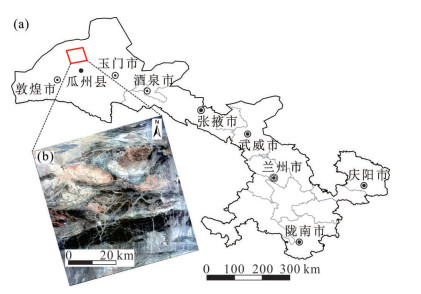
 下载:
下载:
